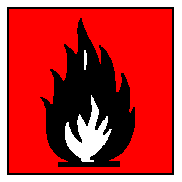International Chemical Safety Cards
| VINYL CHLORIDE | ICSC: 0082 |
VINYL CHLORIDE |
 |
 |
| TYPES OF HAZARD/ EXPOSURE |
ACUTE HAZARDS/ SYMPTOMS |
PREVENTION | FIRST AID/ FIRE FIGHTING |
| FIRE | Extremely flammable. Gives off
irritating or toxic fumes (or gases) in a fire. |
NO open flames, NO sparks, and
NO smoking. |
Shut off supply; if not possible
and no risk to surroundings, let the fire burn itself out; in other cases extinguish with
powder, carbon dioxide. |
| EXPLOSION | Gas/air mixtures are explosive.
Vinyl chloride monomer vapours are uninhibited and may form polymers in vents or flame
arresters of storage tanks, resulting in blockage of vents. |
Closed system, ventilation,
explosion-proof electrical equipment and lighting. Use non-sparking handtools. |
In case of fire: keep cylinder
cool by spraying with water. Combat fire from a sheltered position. |
| EXPOSURE | |
AVOID ALL CONTACT! |
|
| INHALATION | Dizziness. Drowsiness.
Headache. Unconsciousness. |
Ventilation, local exhaust, or
breathing protection. |
Fresh air, rest. Refer for
medical attention. |
| SKIN | ON CONTACT WITH LIQUID:
FROSTBITE. |
Protective gloves.
Cold-insulating gloves. Protective clothing. |
ON FROSTBITE: rinse with plenty
of water, do NOT remove clothes. |
| EYES | Redness. Pain. |
Safety goggles, or eye
protection in combination with breathing protection. |
First rinse with plenty of water
for several minutes (remove contact lenses if easily possible), then take to a doctor. |
| INGESTION | |
Do not eat, drink, or smoke
during work. Wash hands before eating. |
|
| SPILLAGE DISPOSAL | STORAGE | PACKAGING & LABELLING | ||
| Evacuate danger area! Consult an
expert! Ventilation (extra personal protection: complete protective clothing including
self-contained breathing apparatus). |
Fireproof. Separated from
incompatible materials (see Chemical Danger). Cool. |
F symbol T symbol R: 45-13 S: 53-9-16-44 Note: D UN Hazard Class: 2.1 |
||
| SEE IMPORTANT INFORMATION ON BACK | ||||
|
||||